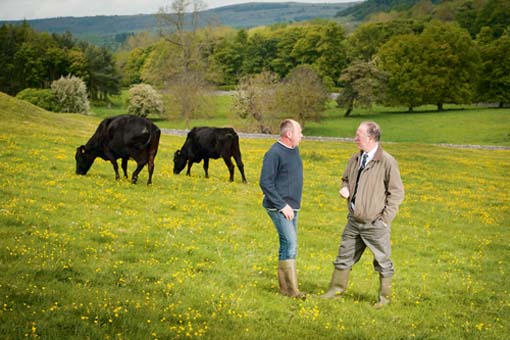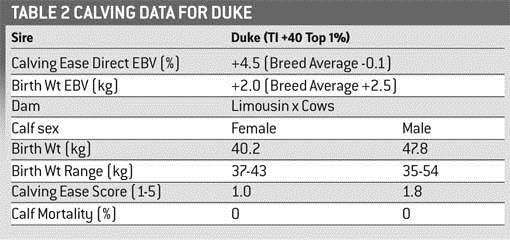Ease of calving the solution to profitable beef production

Ease of calving, high daily carcass gain and calving routine are key factors influencing the profitability of suckled calf production. Jeremy Hunt reports
High index Charolais bulls are used across Simon Frost’s herd of Limousin x Holstein-Friesian sucklers – including the bulling heifers.
It was a decision Mr Frost took based on the confidence he has in the bulls’ Calving Ease Direct EBV which have a high accuracy percentage. “It avoids keeping a bull of a different breed which would probably lead to calves from heifers with a lower daily carcass gain,” he says.
The Charolais has the highest carcass weight for age figure of all the beef breeds, but this is associated with the highest incidence of difficult calvings since high growth rates are correlated to increased calf birthweights which in turn creates issues with calving difficulties.
But Simon Marsh, senior lecturer at Harper Adams University who is monitoring the performance of Mr Frost’s herd, says there is more variation within a breed than between all of the major beef breeds.
“There are easy calving Charolais bulls as well as very hard calving Charolais bulls. Mr Frost meticulously studies bull sale catalogues to search for bulls that are “curve benders”. These are the easy-calving bulls identified by their EBVs but which also have very high growth rates and muscle area.
“The Breedplan performance recording system helps breeders identify bulls with the growth and muscling the breed is renowned for. But it’s also important to note that the latest figures show there’s been an improvement in Calving Ease of the national Charolais herd. The Charolais is the only beef breed to have achieved this.”
Learning from the poultry sector
Both Mr Frost and Mr Marsh believe the beef sector should mirror the achievements made in the poultry industry.
“This sector doesn’t receive subsidy and producers have had to focus on genetic improvement for growth and FCR,” says Mr Marsh.
“In the 1950s it took a bird 77-84 days to get to table weight. About 15 years ago it took 42-43 days to get to 2.25kg with an FCR of about 1.8- 1.9. Now it takes 35 days with an FCR of 1.7. What must be considered is that despite this fantastic increase in growth rates the egg has never got any bigger.”
Mr Frost says pedigree breeders must give greater priority to calving ease.” There’s no place for hard calving bulls in the beef industry. Easy calving bulls can be identified by the Calving Ease Direct EBV. This should be a positive score with a high accuracy of at least 45% but ideally over 50%. Using these bulls on cows that are in lean condition (score 2) at calving will significantly minimise calving problems and deaths.”
Ease of calving data compared
The calving data from the 2011 calf crop of Simon Frost’s top 1% performing suckler herd at Hopping Farm, Youlgreave, Derbyshire, is presented in table 1. It compares the calving results from two sires, Littlebovey Altra and Balthayock Clifford.
When comparing the two bulls it’s clear Altra has the best Calving Ease Direct EBV (+2.4) compared with Clifford ( -3.1) and lower Birth Weight EBV (+2.2kg) compared with (+3.6kg). But Clifford has the highest 400-day weight EBV (+62kg) compared with Altra (+44kg) and Terminal Index (+45) compared with (+35).
Mr Frost says the results clearly show how faith can be put in EBVs. Altra’s calves are born lighter with an easier calving score. The Calving Difficulty score is based on a scale from 1 (unassisted) to 5 (caesarian).

Body condition
Altra was used on the replacement heifers which are run with the bull three weeks before the main herd. He was then run with a group of cows. The calf birthweights recorded from the cows were an average 6.2kg heavier compared with the first calving heifers – something Mr Frost attributes to the condition of the heifers.
“The heifers started the winter in mid pregnancy in fit condition (score 3-3.5) and were outside living off snow and straw as well as 3.5kg of 45%DM silage and free access mineral buckets,” says Mr Frost.
The heifers were housed four weeks before calving in early January and fed a low energy diet based on 6kg of silage and ad lib straw which supplied only 62 MJ of ME. The heifers calved down at condition score 2.25 and calving problems were minimal.
Calving routine
But Mr Frost’s approach to managing calving and minimising losses is based on ensuring he’s present at the birth – something that does mean some late nights or early starts in the morning, says Mr Marsh. “It’s only practical with a compact calving period but this supervision ensures the calf receives its first vital colostrum intake within 30 minutes of being born.”
Mr Frost has developed his calving routine over many years and through experience believes beef producers have come to rely on calving ropes especially when the head and shoulders are already presented.
“The calf that died from Clifford was one out of 29 bull calves that were born. It was a thick, heavy shouldered and well-fleshed calf weighing 47kg. The cow had a very difficult calving last year so she has been marked for culling.
“This year the vet was only called out once to deal with a difficult calving. It was a big calf presented backwards so the decision was taken to carry out a caesarian in order to get a live calf.”
Despite this loss, a mortality rate of 1.2% from 84 calves sired by the two bulls is considered “exceptional performance” by Mr Marsh.
Overall calf mortality for the herd was 0.8% which compares favourably to calf mortality rates in average and top one-third EBLEX-recorded LFA sucker herds of 2.2% and 1.7% respectively.”
The third bull used last year was Swalesmoor Duke. He has a Calving Ease Direct EBV of +4.5, a Birth Weight of +2.0kg, a 400 day weight EBV of +48kg and a Terminal Index of +40.
“These figures make him a Top 1% bull. His calving data (shown in table 2) clearly identifies him as having the easiest calving figures of the three bulls and confirms the reliability of EBVs,” says Mr Marsh.
Says Simon Frost: “The results from the 2011 calf crop clearly prove that EBVs work and will improve performance and profit.”

Embracing EBVs like the Americans
And according to Mr Marsh the beef industry must embrace EBVs like they have in north America and Australia. “In North America and Australia breeding bulls are often purchased ‘blind’ and selected purely on EBVs. They are also starting to embrace genomic enhanced EBVs using DNA technology to identify factors such as tenderness, marbling and to identify dry matter intake and residual feed intake.
“Some pedigree breeders in the UK are now using this technology to aid breed selection and improvement. I’m convinced it will provide a lot more data to support bull buying decisions,” he says.
“Most UK beef producers would never buy a bull without seeing it in the flesh and watching it walk and assess his style. My plea to the industry is that if he has an ugly head or his ears are in the wrong position don’t reject him if he has fantastic EBVs.”
Easy calving solutions
• Select bulls with positive Calving Ease Direct EBVs and high 400-day and eye muscle area EBVs ie “curve benders”
• Aim for accuracy figures of 45% or higher with the Calving Ease Direct EBV
• Target Birth Weight EBV ideally at breed average or lower
• Calve cows at Condition Score 2
• Have faith in EBVs
HABFF
